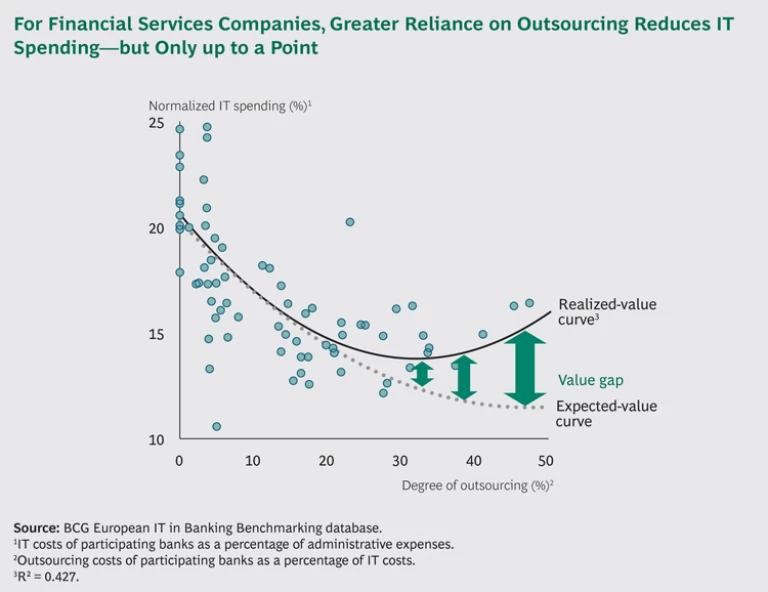IT outsourcing can be a potent lever in professionalizing IT services and driving down IT costs, and companies continue to exploit it to various degrees. Yet many outsourcing efforts ultimately disappoint, with hoped-for gains in speed, flexibility, and service quality failing to materialize. (See “Signs of IT Outsourcing Gone Awry,” below.) And solutions can be elusive. Many executives become so frustrated, in fact, that they eventually throw up their hands and opt to bring some, if not all, of the outsourced work back in-house.
Signs Of IT Outsourcing Gone Awry
Fundamental problems with IT outsourcing rarely appear without warning—there are typically cues along the way. These might include the following:
Costs
- The ratio of IT costs to company revenues does not improve.
- The underperformance of vendors necessitates frequent financial settlements to compensate the company.
Service Quality
- There is low satisfaction within the company with the performance of key areas or functions—for example, the service desk.
- Vendors meet contracted service-level agreements but do not solve the underlying problems; as a result, problems recur.
Agility and Responsiveness to the Business’s Needs
- Expected gains in agility and responsiveness fail to materialize because the vendor or vendors cannot free up the right resources for the project or challenge at hand.
- The company must frequently take corrective action to fix problems in areas tasked to vendors, keeping internal resources occupied with low-value activities and thus delaying completion of the company’s high-priority projects.
- The time it takes to resolve major incidents increases, leading to high system downtime.
If your company is experiencing any of these, it is time to act.
Are there ways to ensure success in this arena? This article, the first in a series on value delivery in IT outsourcing, explores the potential benefits that draw companies to outsourcing and the reasons why many businesses fail to capture them, and it identifies the symptoms of a floundering outsourcing program and how to put it back on track.
The Gap Between Aspiration and Reality
Outsourcing can create value for companies by providing three primary benefits: lower costs, higher service quality, and greater agility and responsiveness to the business’s needs. Outsourcing companies can deliver lower costs through greater economies of scale, access to low-cost labor, and process efficiency derived from their experience and focus on process maturity and continuous improvement. They can deliver higher service quality because of the maturity of their processes and their access to and familiarity with the latest technologies. They can deliver improved agility and responsiveness through their advanced project-management skills, their ability to quickly ramp up or scale down resource capacity, and their ability to access and leverage collaborative development methods, such as agile software development. And outsourcers can deliver these capabilities on demand, sparing companies the considerable effort and time it would take to build them internally.
Each of these benefits can translate into meaningful competitive advantage. But realizing their potential value can be problematic. Take costs, for example. The potential for cost savings remains the single biggest lure for companies that outsource elements of their IT. Yet surveys reveal a high degree of dissatisfaction with the cost savings realized from IT outsourcing.
BCG’s experience confirms this finding. Indeed, we have found a particularly striking relationship between IT costs as a percentage of administrative expenses and a company’s reliance on outsourcing (measured by outsourcing’s share of total IT spending). Our research indicates that, for many companies, rising IT cost savings correlate with increasing deployment of outsourcing only to a degree. For example, a recent BCG benchmarking study revealed that IT costs as a percentage of administrative expenses at financial services companies do indeed fall as outsourcing increases. But after a certain point, IT costs as a percentage of administrative expenses actually begin to increase. (See the exhibit.) Moreover, we have observed a similar relationship between outsourcing and IT costs for companies in other industries, and the pattern holds over time. This suggests that a company’s ultimate return on outsourcing will be capped unless it can identify and remedy the underlying problems.
These problems can take any number of forms. For example, one company that was seeking to reduce its outsourcing costs through contract renegotiation saw its efforts undone when the winning vendor began to delay the delivery of key projects, limit resource availability, and reduce its investments in service in an effort to recover its profit margin. Another company, hoping to streamline and simplify its application landscape in order to achieve greater agility, abandoned its existing outsourcing program (which involved more than 300 vendors) and established a cosourcing business unit led by a single vendor and the company’s IT department. The company failed to manage the transition well, however, resulting in a loss of critical know-how and delays in project completion.
A third company, seeking to improve its service quality, negotiated a large outsourcing deal with a leading infrastructure vendor. But the vendor failed to perform at the promised level because of internal misalignment and bickering, with the account representative blaming both the terms of the deal (“This is a money loser”) and the vendor’s management structure (“Each of the many internal groups working on your behalf has its own incentives, and I have no control over them”).
As these examples illustrate, vendor underperformance is a common reason why outsourcing efforts skid off the rails. A vendor may have oversold its capabilities and be unable to deliver the targeted service levels at the specified price. But the fault lies nearly as often with the company itself. IT management may lack the necessary capabilities to negotiate the outsourcing contract or manage the company’s outsourcers efficiently. Or the company may be operating at the wrong scale to realize the desired savings. Or vendor KPIs and incentives may be unclear or misaligned with the company’s objectives.
Ensuring Outsourcing Success
There are essentially two avenues for addressing these types of problems. The first is a review of vendor contracts, potentially followed by their redefinition or renegotiation. A new or improved contract will help protect the company’s interests on multiple levels. It will provide appropriate incentives to ensure that the vendor’s (or vendors’) interests are aligned with the company’s needs and expectations. It will minimize or eliminate the possibility of unexpected costs, such as settlement fees or training costs. And it will ensure that the collaboration between company and vendor is set up for success. Contract and vendor management must be ongoing.
The second, more important, and often forgotten lever for ensuring successful IT outsourcing is optimization of the company’s IT-outsourcing operating model. This entails action on several fronts:
- IT service-delivery processes must be examined from top to bottom to identify key opportunities for improvement.<
- The company’s internal IT organization must possess the ability to effectively orchestrate relationships with vendors and ensure that handover points are managed smoothly. This entails a definition of processes and of roles and responsibilities.
- The IT organization must be able to effectively manage the business’s demands and identify the required IT systems and services.
- The appropriate metrics and incentives for all parties must be in place and there must be sufficient transparency to allow for proper monitoring, measurement, and steering.
Achieving maximum value from IT outsourcing is not easy. It requires a strong internal IT organization, committed and capable vendors, and an optimized relationship between the two sides, supported by a solid contract. Future articles in this series will look at these levers in detail, including an examination of best practices in IT-outsourcing contract structure, content, and execution and how to drive end-to-end improvement in the company’s IT-outsourcing operating model.








